3-Way Invoice Matching: How to Build a Bulletproof Workflow
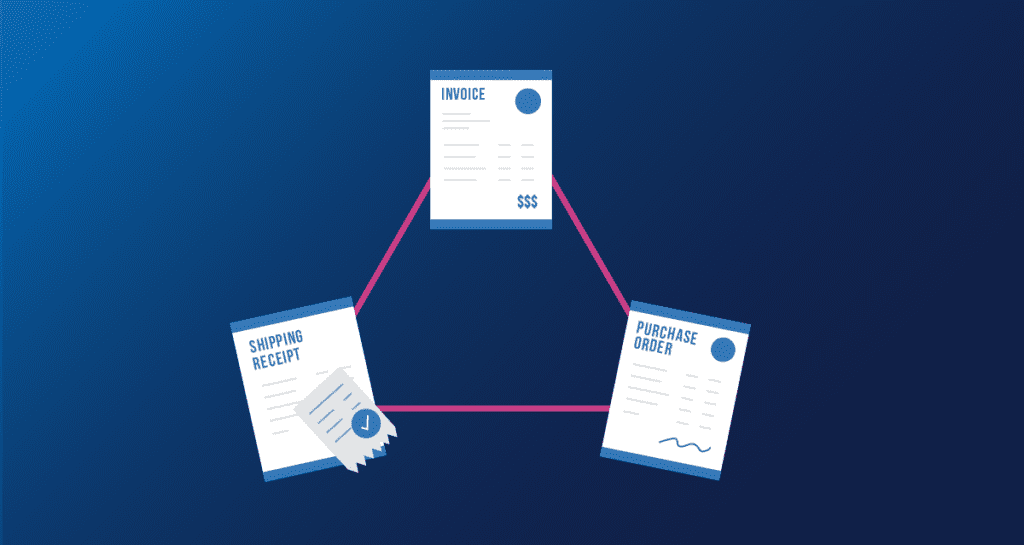
Invoice accuracy is everything.
In 2021, Stampli surveyed finance teams across America on invoice management processes. Just over one-third (37%) said they use three-way matching to confirm invoices.
Not surprisingly, the same survey reported that “slow approvals” was the biggest headache facing AP teams.
Having a great Accounts Payable process isn’t much good if there is no system in place to verify invoices before paying them. Without a process to check invoices for fraud or human error, your business risks making late payments or unintentionally approving supplier payments based on bad information.
It’s like garbage in, garbage out – except you’re the one left holding the bag.
Three-way matching is the tried-and-true process of verifying invoices by comparing them to purchase orders and receiving reports. It ensures the goods or services have been received as ordered, and the invoice matches the purchase order and receiving report.
Fraud costs businesses 5% of their annual revenue every year. As an important internal control, three-way matching helps your business protect its bottom line.
In this article, we’ll discuss the advantages of using a three-way matching process for your business. We’ll delve into the costs and benefits of this approach and how to set up an effective three-way matching workflow. Additionally, we’ll explore the benefits of automating your invoice processing.
Let’s start with a definition of three-way matching.
What is 3-way matching?
I’m the Director of the purchasing department at an HVAC systems manufacturer. We design and build climate control and building control systems for multi-tenant residential and commercial properties across the US.
Our procurement situation is complex. We have a large global supply chain and work closely with construction and other mechanical companies on projects. We must have an accurate picture of our supply costs to ensure each project’s profitability. That means we need to stay on top of our invoices to ensure they’re accurate.
Our accounting department currently uses a semi-automated three-way matching system to verify invoices. It’s effective, but it’s labor-intensive and takes a long time to review invoices. We’re concerned that errors and fraudulent invoices are getting through and we’re making overpayments. Our CFO has asked me to look into improving the efficiency of the verification process.
Simply put, three-way matching entails cross-checking an invoice with the corresponding purchase order and delivery receipt to make sure everything matches. If they do, great, we pay the invoice. If not, we kick the invoice back to the supplier and ask them to clear things up.
The actual process is a bit more complicated, so let’s break it down, beginning with the three documents being matched.
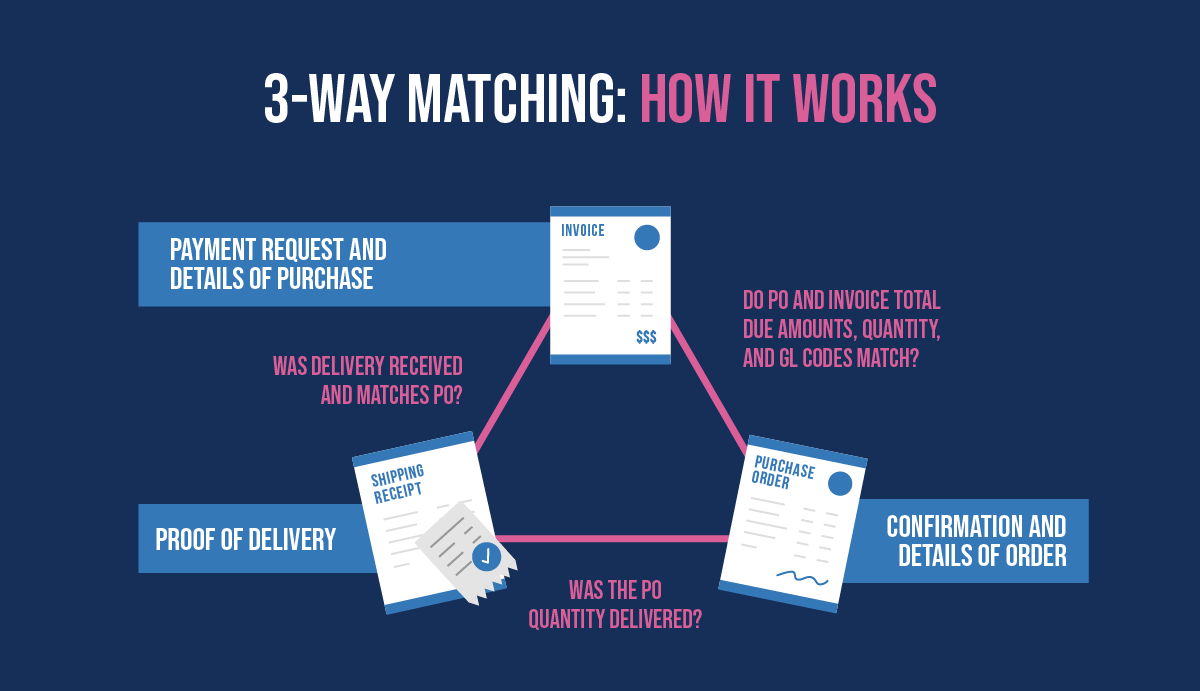
Components of 3-way matching
Three-way matching requires the contents of three documents to match. Listed in the order we use them, these are:
Purchase Order (PO)
As the first document, we send the purchase order to the vendor to authorize the purchase. The PO includes our company name and address, the order date, the PO number, descriptions and quantities of the goods or services we’re ordering, and the agreed-upon pricing.
Delivery Receipt
Also called the order receipt, shipping receipt, goods receipt note, or packing slip; this is a detailed list of the products the supplier has delivered in a shipment. Usually, the delivery receipt contains the same information as the invoice, but not always, as we’ll see. Sometimes, the supplier may only deliver part of an order, which they would reflect on the receipt.
Supplier Invoice
After the supplier completes the shipment, they send us an invoice. The invoice contains the invoice number and all the info from the PO, including our name and address, PO number and order date, the products and services delivered, pricing, taxes, and the total amount due. The invoice may also contain credits, early payment discounts, or notes indicating products still to be delivered.
Once we’ve received the invoice, we can match it against the PO and receipt to verify the information.
The 3-way matching process
Three-way matching works by comparing the quantities, pricing, terms, and other information to ensure that what we ordered (PO) matches what we received (shipping receipt) and what we’re being charged. (invoice).
In general, our AP team goes down a checklist every time they match an invoice:
Purchase order verification: Does the purchase order include the amount to be paid, the name and address of the supplier, correct GL codes, accurate descriptions of the products or services, and any other required info?
Delivery verification: Do the products and quantities on the shipping receipt match those ordered on the PO? If not, is there an explanation (item back-ordered, out of stock, etc.)
Invoice verification: Does the total amount due match the amount authorized on the PO? Do the products and quantities match those on the PO and shipping receipt? If we received a partial shipment, is the supplier asking for partial or full payment? Is the invoice for more than one PO or part of a single PO?
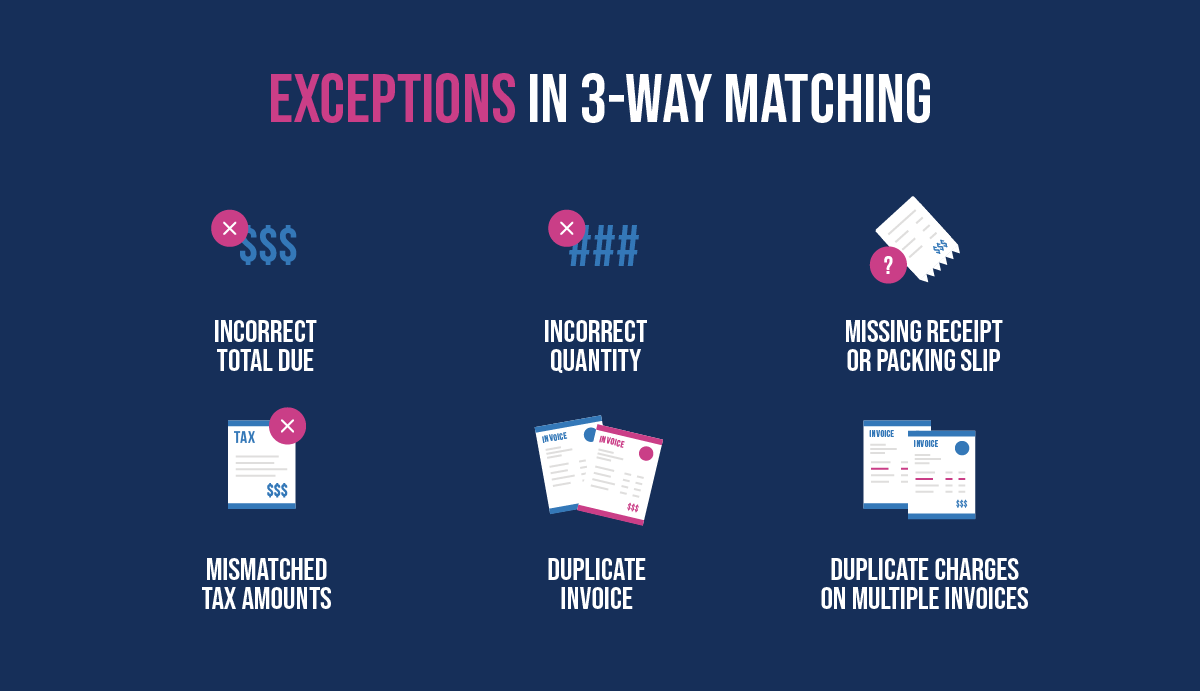
If everything matches, our AP team sends the invoice on for approval and payment. If not, we either confirm the shipment ourselves (see four-way matching below) or kick it back to the supplier for them to fix it.
We also use two other matching processes for special situations where three-way matching may not be possible or further investigation is required.
2-way matching
We use two-way matching when we have a PO and invoice but no shipping receipt. Usually, this is when the shipping receipt has been lost (or one wasn’t issued) or for recurring expenses, like software subscriptions.
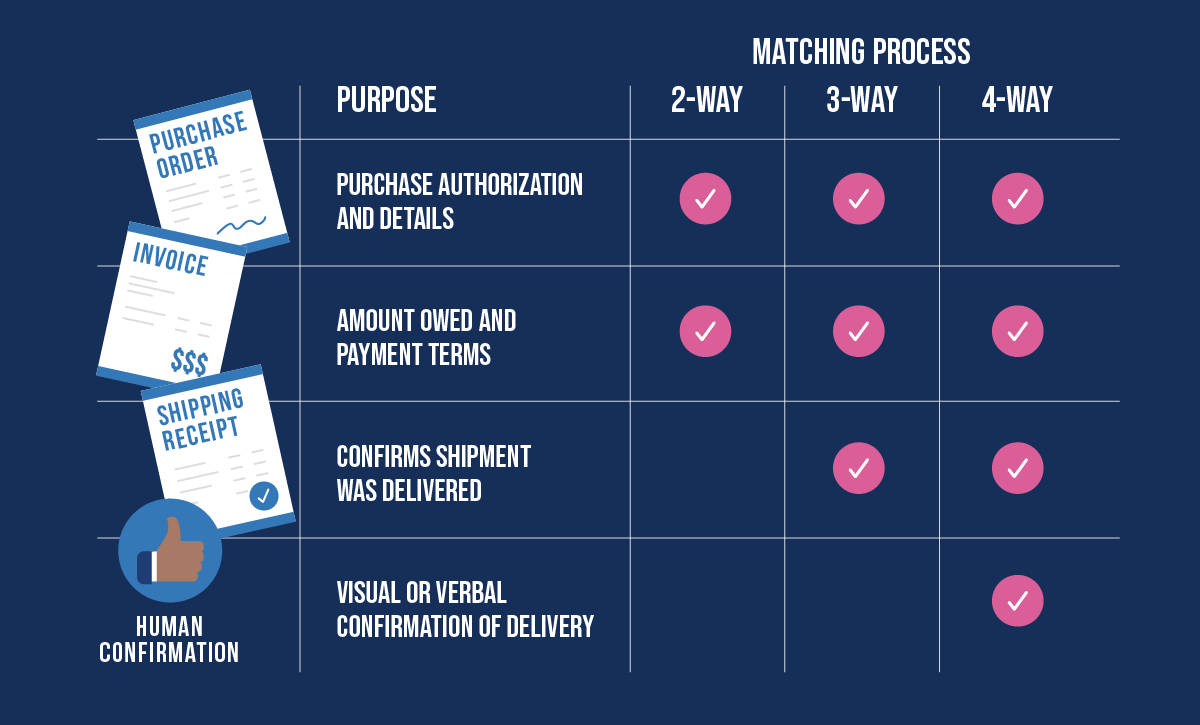
4-way matching
Everyone makes mistakes. Sometimes when an invoice, PO, and receipt don’t match, we’ll confirm the purchase ourselves. The confirmation depends on the type of purchase. For example, we may check with the receiving department to confirm we received the delivery, search our warehouse directly, or even check if someone tossed it in the back of one of our trucks.
Our current four-way matching process effectively solves problems but is time-consuming and ties up our employees. We want to streamline our procurement process by improving accuracy and reducing the need for physical checks. We can do that by developing a solid three-way matching process.
Building an efficient three-way matching workflow
There are several benefits to having a good three-way matching workflow, such as a cleaner audit trail, reduced fraud, and better supplier relationships. However, the biggest benefit for us is that it lets us quickly detect and fix errors before we send invoices for approval. A good three-way matching workflow lets us approve and pay invoices faster by reducing the number of wild goose chases and vendor disputes.
Here are the basics of building an effective workflow.
Step 1: Define the three-way matching process and thresholds
The first step in designing the workflow is to document and map your current P2P processes and establish rules around when and how you will verify invoices. To save time and resources, it’s helpful to set thresholds for when your AP team should verify an invoice:
Value threshold: High-value POs and invoices represent the largest potential financial loss. You can set a threshold that you only verify invoices over a certain dollar amount to mitigate this risk.
Discrepancy threshold: Sometimes, a small discrepancy between the PO and the invoice is normal. You can make your three-way matching process more efficient by only verifying invoices within a specified percentage of the PO amount.
Vendor quality rating: Rate vendors based on their invoice accuracy to improve efficiency and reduce risks. High-rated vendors may only need occasional spot checks, while low-rated ones require frequent verification.
Once you’ve mapped your existing process and set thresholds, you can look at ways to improve the process.
Step 2: Identify stakeholders
The next step is identifying the stakeholders involved in the procure-to-payment process, such as your AP team, purchasers, receivers, and suppliers. It’s important to include everyone involved in the process so each stakeholder understands their roles and responsibilities. For example, we include our project managers because they oversee procurement. In addition, we include subcontractors during individual projects because they have first-hand knowledge of what we’re spending. When everyone knows their job, the workflow becomes a lot more efficient.
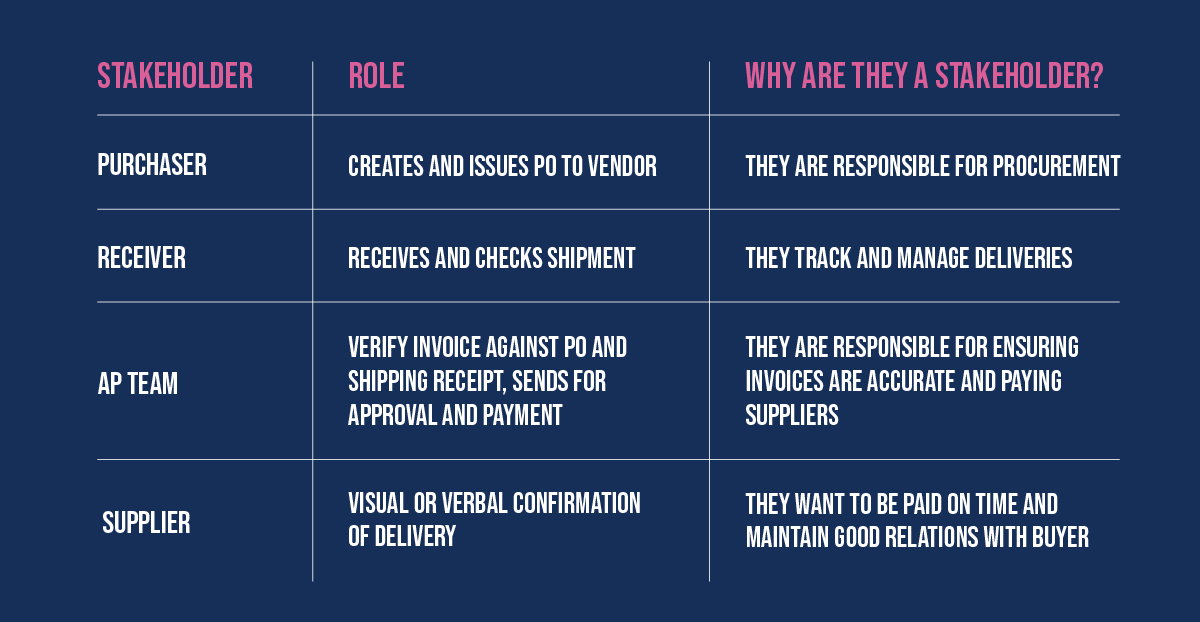
Step 3: Define communication channels
Once you’ve established your criteria and defined stakeholders, develop the communication channels stakeholders will use to communicate with each other. As a rule of thumb, we like to keep communications simple and centralized so everyone is on the same page.
Set out the policies and procedures for communications tasks like delivering POs, receipts, and invoices to your accounts payable department, confirming line items and invoice details, accepting or rejecting an invoice, and forwarding an invoice for approval.
Step 4: Choose what to automate
As you develop your three-way matching workflow, you may identify tasks and processes, such as invoice scanning and entry, where automation software may improve efficiency. Your choice of tool could include an automatic invoice scanning system, AP automation solution, invoice matching software, or an ERP.
Choosing the right tools to automate these processes and reduce your reliance on manual workflows as much as possible is essential. For example, we chose an accounts payable automation solution because it provided end-to-end automation of our invoice management processes. Let’s talk about how that helped us improve our workflows.
Improve 3-way matching with AP automation
Manual three-way matching is an effective way to verify invoices when documents match. However, discrepancies can bog the process down fast.
For example, if the invoice and shipping receipt don’t match, our AP clerk needs to go track down the shipment. In our business, that could mean calling a project manager (who is probably on-site supervising a job), physically searching our warehouse for the shipment, or even driving out to a work site. As you can imagine, as the number of shipments and invoices increases, so does the potential number of discrepancies.
Even if there aren’t any discrepancies, the manual matching process isn’t ideal. Our accounts payable team spends a lot of time searching through paperwork to find the three documents, visually checking each document to make sure they match, and then logging the match (or discrepancy) in Excel. Mistakes get made, and incorrect invoices do get through. Sometimes, we catch them during the invoice approval process, but I’m sure we’ve paid a few invoices we shouldn’t have.
Instead of sending our AP clerks to search file cabinets for paper documents or having them go through hundreds of emails to find a PDF attachment, an automated system can do the job instantly. Automation does this by using AI and machine learning to automatically scan, code, enter, group, and compare invoices, POs, and receipts.
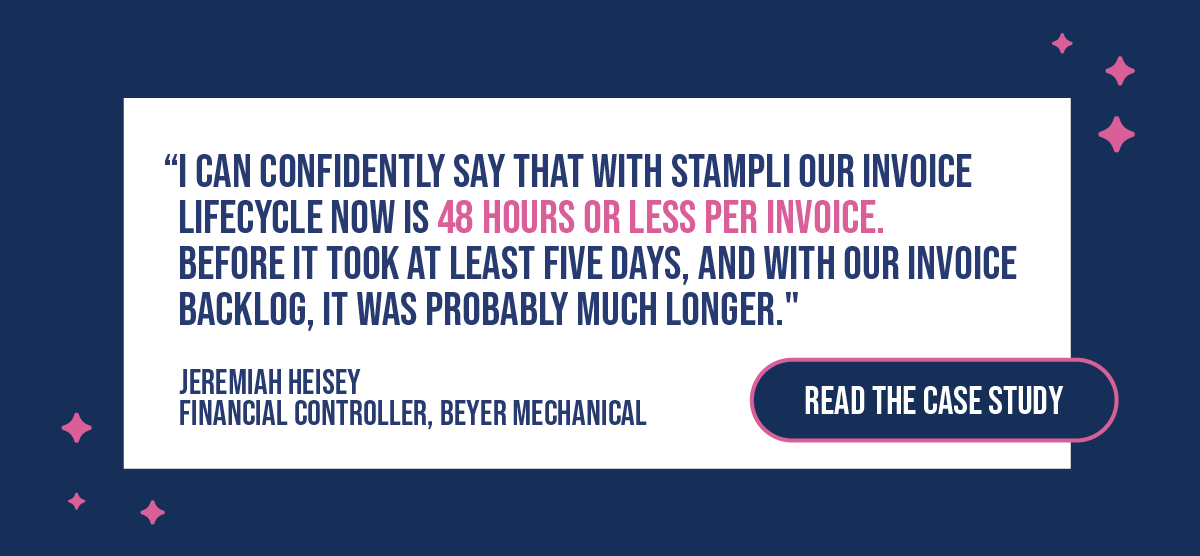
As a component of an Accounts Payable Automation solution like Stampli, automated 3-way matching lets us match every vendor invoice we receive. Not only does this make detecting discrepancies much easier and faster, but it also lets our AP clerks quickly identify and resolve issues.
For example, if a shipping receipt and invoice show different quantities, the clerk knows to work with our receiver to check the inventory. Or, if an invoice shows a charge for a product that appears on the PO but not on the shipping receipt, the clerk can confirm with the vendor if the product has shipped or is back-ordered.
Automatically verifying every invoice helps us drill down into problems with our P2P process and supply chain. For example, if a supplier consistently sends incorrect invoices and shipping receipts, we can address the issue with them.
Finally, our AP automation solution seamlessly integrates with our ERP, Sage Intacct Construction, to share real-time transaction information across our company. We use Sage for supplier payments, so our approvers can tell at a glance if an invoice has already been verified before they approve it for payment.
Stampli: invoice automation evolved
Stampli is the only Accounts Payable Automation solution specifically designed to meet the unique needs of AP departments. It streamlines invoice management, eliminating the need for external communication, ad-hoc workarounds, and manual AP tasks. Stampli provides complete visibility into every transaction, making three-way matching, audits, and month-end close easy and informing strategic business decisions.
Stampli is simple for users to learn and even simpler to use, especially with Billy the Bot™ automating nearly all your procure-to-pay workflows. Using AI and machine learning, Billy quickly captures and codes transaction data from paper or electronic receipts and can understand all line types, including general ledger, charges, fixed asset lines, and resources.
Billy can also handle partial payment workflows and multiple POs and support invoice management for multiple subsidiaries, locations, currencies, and tax structures. Billy can also identify errors and signs of fraud that are often easily missed, such as slight changes to invoice details or inflated line items.
Billy streamlines communication and collaboration throughout the three-way matching workflow by consolidating all invoice communications on the same page with the invoice. Additionally, Stampli integrates smoothly with more than 70 ERPs and accounting systems to ensure consistent transaction data across the organization.
The case studies speak for themselves. Stampli delivers real results by helping businesses optimize invoice processing without changing their ERP system or AP processes. Contact us today to set up a free demo.